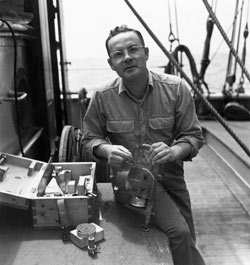This is an archived site. This site is no longer being maintained or reviewed for broken links.
Employee Portrait Gallery—Nat Corwin
 |
|
|
Nat Corwin assembles a current meter during his first WHOI cruise aboard Atlantis to the Mediterranean in 1948. (WHOI Archives Photo)
|
Nat Corwin survived the sinking of the Navy survey ship Quincy in 1942, and he participated in the two-ship “trade-winds “cruise when Atlantis lost its mizzen mast in 1952. He was chief scientist aboard Atlantis II in 1962 when the call came to assist with the search for the sunken U.S. submarine Thresher, and he was also aboard A-II when the ship was damaged in 1964 by a maverick wave estimated at 40 feet.
But what he’s best known for is many years of painstaking nutrient analysis of seawater ashore and afloat—at a time when there was nothing automated about collecting this data. Colleague and shipmate Ralph Vaccaro says, “Nat was extremely devoted to his work, committed, and dependable—and also very social, which made him a good companion at sea.” When Nat received his 30-year service award, the presenter noted that his Navy quartermaster training more than proved its worth as Nat supervised the loading and securing of scientific equipment and supplies for cruises, “and we never lacked bottles or reagents, nets or thermometers or any other necessity for the work.”
Nat grew up on Long Island, joined the Navy at age 20 in 1940, and served until 1946. He had returned home and was working for a civil engineer when Navy shipmate Martin Pollak, a WHOI physical oceanographer, contacted him about joining the 1948 Atlantis cruise to the Mediterranean. Nat signed on as a bathythermograph observer and then made WHOI his career. About a year later, he moved to Buck Ketchum’s group to do chemical analysis on a cruise. He continued this work for Buck Ketchum for many years and later did the same for John Ryther’s laboratory, working both in Woods Hole laboratories and logging many cruises aboard Atlantis, Bear, Crawford, Chain, Gosnold, Albatross III, and Atlantis II. “The best part was that everybody got along and helped one another,” Nat says.
Nat served as a long-time United Fund chairman for WHOI. He retired in 1986 and currently volunteers in the WHOI Archives, helping to document the Institution’s large historic photo collection.
[back]

